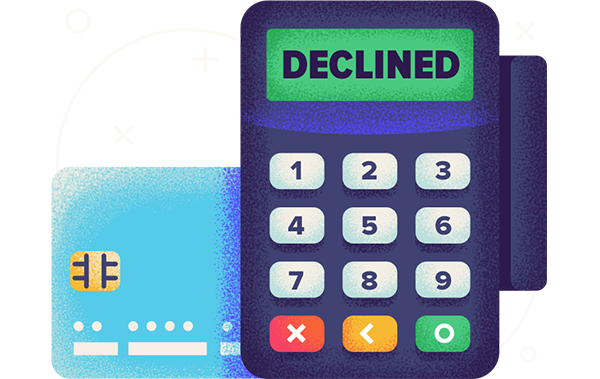Credit cards get declined for various reasons, ranging from fraud concerns to missed payments and maxed out credit lines. It’s important to determine why your credit card was rejected because this will dictate your options moving forward.
Top Reasons Your Credit Card Might Get Declined
- You’ve maxed out your credit limit
- Your credit card is expired
- You haven’t activated your card
- Your credit card has been cancelled
- Your credit line has been reduced
- Your purchase appears “suspicious”
- You’ve missed payments
- There’s a hold on your credit line
- You didn’t enter your information correctly
- The primary account holder made changes
- Your credit card format isn’t recognized
- The card reader malfunctioned
- Your credit card was physically damaged
Why Was My Credit Card Declined?
Credit cards get declined for various reasons, ranging from fraud concerns to missed payments and maxed out credit lines. It’s important to determine why your credit card was rejected because this will dictate your options moving forward. You can learn about each of the potential causes of a declined card in detail below.
1. You’ve maxed out your credit limit
“Maxing out” your credit card is one of the most common reasons for a declined transaction. This means that you have used all of your available credit and will need to make a payment before being able to spend again.
Not only does maxing out a card prevent you from making new purchases, but it’s also bad for your credit score. We recommend using no more than 30% of your card’s credit limit at once and paying down at least part of your balance if you exceed that before spending more.
2. Your credit card is expired
Despite the fact that we’ve typed in or recited our card expiration date countless times, we still often forget and attempt to use our card past its valid period. While your credit card may continue to work after it has expired, this is the exception rather than the rule, and an expired card is still a common reason for a transaction to get declined.
Typically, your issuer will automatically send you a new card at least a few weeks before your old one expires. If it’s getting close to your expiration date and you have not received a replacement, you should contact the issuer because the new card could have fallen into the hands of a fraudster.
3. You haven’t activated your card
When you get a new credit card, it will bear a sticker instructing you to activate it by calling or visiting the issuer’s website. If you skip this step and attempt to make a purchase, the transaction may get declined.
4. Your credit card has been cancelled
Due to a variety of reasons – whether it’s theft, fraud, delinquency, missed payments or inactivity – your card could have been cancelled. Either the notification announcing this change has not yet arrived or you may have missed it, thinking the letter was junk mail.
5. Your credit line has been reduced
Credit card companies are allowed to reduce your credit limit at any time. They do not even have to provide notification unless the change brings your credit line below an existing balance (or unless it’s been reduced due to negative information on your credit report).
Therefore, it’s conceivable that you could go to make a purchase thinking you have plenty of available credit, only to find yourself on the wrong end of a declined transaction.
6. Your purchase appears “suspicious”
Credit card companies are constantly on the lookout for fraudulent activity on consumers’ accounts. Not only do they want to mitigate fraud as a customer service, but issuers and merchants are the ones who are liable for fraudulent charges – not you – so they want to save themselves money as well.
A number of different types of account activity can trigger a credit company’s fraud monitoring system, including purchases made outside of your normal geographic area, numerous transactions in a short period of time, abnormally expensive purchases, and large purchases made soon after small ones (as thieves often do that to test out a stolen card). If your transaction gets declined under suspicion of fraud, you’ll just have to talk to your bank and let them know that it’s legitimate. This usually just requires you to answer a few security questions.
One good thing is that all major credit cards come with a $0 liability guarantee. This means that consumers are not responsible for unauthorized transactions on lost or stolen credit cards.
7. You've missed payments
If you become delinquent on your credit card bill, the issuer may shut off your ability to make new purchases in order to prevent you from incurring more debt and prompt you to make a payment. As long as you have enough money in your bank account, setting up automatic payments can ensure that you won’t miss a payment again.
8. There’s a hold on your credit line
Hotels, car rental companies and other service providers often put holds on customers’ credit cards to ensure they’ll receive payment in the event the customer incurs any incidental charges, such as fees for damage to their room or vehicle. A hold sets aside a portion of your credit limit so that it can’t be used for any other transaction. Holds aren’t always processed and charged in the end, but they do limit your purchasing power for the time being.
9. You didn’t enter your information correctly
People often mistakenly provide the wrong credit card number, expiration date, CVV code or billing address when paying online or over the phone. All of this information must match what the credit card company has on file for a transaction to be approved.
10. The primary account holder made changes
This is only applicable to authorized users. If the primary account holder – typically a parent or business owner – makes changes to the account, those changes will affect you too. Therefore, if they cancelled their account, your card will be rendered unusable.
Some companies even allow primary cardholders to set limits on authorized users’ purchases, so you may have already spent the maximum the primary cardholder has allowed.
11. Your credit card format isn’t recognized
You will need a chip-and-PIN card to make purchases at unattended kiosks in other countries, such as those you might find in a train station or parking garage. Since most U.S. credit cards are chip-and-signature, you may have to use a debit card instead.
In addition, starting in 2027, banks will no longer be required to even have a magnetic stripe on their credit cards anymore, so that way of paying may be entirely phased out in the future. Mastercard, for example, won’t include magnetic stripes on any cards from 2029 onward. It’s possible this transition could cause your card to be rejected if there are still any merchants that haven’t updated to EMV or contactless card readers.
12. The card reader malfunctioned
Sometimes the problem lies with the merchant, instead of you. It’s possible their credit card reader is damaged and having trouble processing perfectly fine credit cards. In such an instance, simply retrying your card may result in the purchase being processed.
13. Your credit card was physically damaged
Damage to your card could prevent it from working for in-person transactions. Fortunately, requesting a replacement credit card is easy. Just get in touch with your credit card company’s customer service department, and they’ll handle the rest.
What to Do If Your Credit Card Gets Declined
- If you’re making a purchase in person, ask the merchant to run it again. The initial failure may have been due to an issue with the merchant’s card reader.
- If you’re shopping online, make sure to re-verify all of your information before resubmitting your card for payment, because a typo could be at fault.
- If the transaction continues to fail, you should contact your bank or credit union using the number printed on the back of your credit card. That will help you determine what’s going on and what your next course of action should be. If the reason is because you’re late on your bill, you could make a payment. Your bank or credit union could also have declined the transaction believing it’s someone else using your card. If that’s the case, verify it is actually you trying to make the transaction.
You may not always be able to solve the issue of your card being declined right away – for example, if your card is damaged and you need a replacement. That’s why you should always have at least one alternative payment method on you at all times, whether that’s a debit card, cash, or even a mobile wallet on your phone.
Credit Card Declined Codes
A credit card declined code is an error message that merchants see when a transaction cannot be completed successfully. There are many reasons why that may happen, and the reason dictates what the merchant should do in response. Asking the merchant which code they got when trying to run your credit card could also help you solve the problem.
| Declined Credit Card Code | Meaning |
| 04 | Merchant Should Keep Card |
| 05 | Do Not Honor |
| 12 | Invalid Transaction |
| 13 | Invalid Amount |
| 14 | Invalid Card Number |
| 15 | No Such Issuer |
| 19 | Re-Enter Information |
| 51 | Insufficient Funds |
| 54 | Expired Card |
| 57 | Transaction Not Permitted |
| 61 | Customer Has Exceeded Withdrawal Limit |
| 62 | Suspected Fraud |
| 63 | Security Violation |
| 65 | Customer Has Exceeded Activity Limit |
| 78 | Transaction Blocked for First Time Card Use |
| 85 | Cardholder Verification Error |
| 97 | Invalid CVV |
How to Prevent Your Credit Card From Getting Declined
To avoid having your credit card declined, make sure to keep your card in good condition and activate any replacement as soon as it arrives. In addition, keep track of your spending and how close your balance is getting to your credit limit so you’re not caught off guard by having too little available credit.
If your card ends up getting declined despite your best efforts:
- Try your transaction again and double check any information you’ve entered manually.
- Check to see if your credit card company has mistaken the transaction for fraud. If the transaction was flagged, you’ll have to tell them it was legitimate, after which they’ll allow a new purchase attempt to go through.
- If all else fails, it may be time to break out a different payment method until you can nail down the root of the problem with the card’s issuer.



WalletHub experts are widely quoted. Contact our media team to schedule an interview.